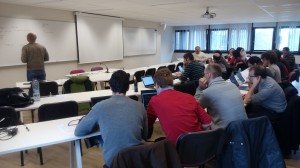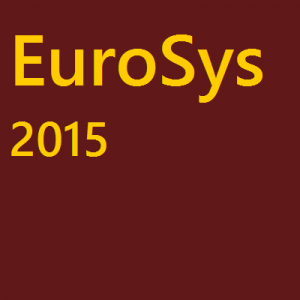Mergeable persistent data structures Irmin is an OCaml library to design purely functional data structures that can be persisted on disk and be merged and synchronized efficiently. In this paper, we focus on the merge aspect of the library and present two data structures built on top of Irmin: (i) queues and (ii) ropes that […]
‘What’s On?’
Trilogy 2 plenary meeting in Louvain la Neuve

The Trilogy 2 consortium met in Louvain la Neuve at the UCL (Université catholique de Louvain la Neuve) (16th-17th February)
Upcoming IETF Meetings. IETF 92 – Dallas, TX USA

Different Trilogy 2 partners will be presenting their work in this meeting (March 22-27)
Jitsu: Just-In-Time Summoning of Unikernels

Jitsu: Just-In-Time Summoning of Unikernels Network latency is a problem for all cloud services. It can be mitigated by moving computation out of remote datacenters by rapidly instantiating local services near the user. This requires an embedded cloud platform on which to deploy multiple applications securely and quickly. We present Jitsu, a new Xen toolstack […]
Queues Don’t Matter When You Can JUMP Them!

Queues Don’t Matter When You Can JUMP Them! QJUMP is a simple and immediately deployable approach to controlling network interference in datacenter networks. Network interference occurs when congestion from throughput-intensive applications causes queueing that delays traffic from latency-sensitive applications. To mitigate network interference, QJUMP applies Internet QoS-inspired techniques to datacenter applications. Each application is assigned […]
Cutting Tail Latency in Cloud Data Stores via Adaptive Replica Selection

Cutting Tail Latency in Cloud Data Stores via Adaptive Replica Selection Achieving predictable performance is critical for many distributed applications, yet difficult to achieve due to many factors that skew the tail of the latency distribution even in well-provisioned systems. In this paper, we present the fundamental challenges involved in designing a replica selection scheme […]
InNet: Enabling in-network processing for the masses

InNet: Enabling in-network processing for the masses Network Function Virtualization is pushing network operators to deploy commodity hardware that will be used to run middlebox functionality and processing on behalf of third parties: in effect, network operators are slowly but surely becoming in-network cloud providers. The market for innetwork clouds is large, ranging from content […]
In-Network Processing, User-Level Stacks and the Future of Internet Evolution

In-Network Processing, User-Level Stacks and the Future of Internet Evolution In this position paper we take such an approach, and discuss two components we believe to be crucial to the future evolution of the Internet. First, we argue for user-level network stacks as a means to allow quicker and easier deployment of novel protocols. Second, […]
Good cop, Bad Cop: Forcing Middleboxes to Cooperate

Good cop, Bad Cop: Forcing Middleboxes to Cooperate In this paper we discuss two fundamentally different directions in which we can improve address the status quo. Our first proposal is a “good cop”: we present an API endpoints can use to understand the contract offered by the network, and discusses how one might implement this […]
Increasing Datacenter Network Utilization with GRIN

Increasing Datacenter Network Utilization with GRIN Various full bisection designs have been proposed for datacenter networks. They are provisioned for the worst case in which every server sends flat out and there is no congestion anywhere in the network. However, these topologies are prone to considerable underutilisation in the average case encountered in practice. To […]



